
The Solar-Terrestrial Centre of Excellence (STCE) is a collaborative network of the Belgian Institute for Space Aeronomy, the Royal Observatory of Belgium and the Royal Meteorological Institute of Belgium.
 |
Published by the STCE - this issue : 1 May 2014. The Solar-Terrestrial Centre of Excellence (STCE) is a collaborative network of the Belgian Institute for Space Aeronomy, the Royal Observatory of Belgium and the Royal Meteorological Institute of Belgium. |
| Archive of the newsletters | Subscribe to this newsletter by mail |
Simultaneous flares are unrelated solar flares in different active regions that occur at nearly the same time. If the flares coincide in time not by chance, but by the triggering of some physical connection, they are called sympathetic flares. More loosely, a sympathetic flare can also be defined as the initiation of a solar flare resulting from a transient phenomenon occurring elsewhere on the Sun. Hence, sympathetic flares are a subset of simultaneous flares.
The distinction between the two, i.e. is the pair of flares somehow physically connected or not, is a difficult problem. Though the existence of sympathetic flares was suggested already in the mid 1930's, their existence is still being debated. Important support for the existence of a physical connection between two far-away regions was given on 1 August 2010, when pretty much the entire visible northern hemisphere erupted. In a matter of hours, various flares and filament eruptions occurred though they were several 100.000 km separated from each other (Note 1).
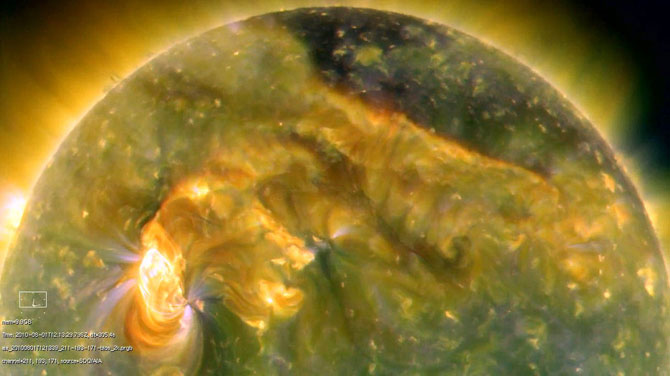
There may be several causes for sympathetic flares. In EUV (SDO/AIA at http://sdo.gsfc.nasa.gov/ ), coronal loops can sometimes be seen connecting active regions, occasionally even crossing the solar equator. Any disturbance in one region can then quickly be "transported" to the other region, where it may induce another flare or filament eruption (image underneath). Also EIT waves (see this news item at http://www.stce.be/news/241/welcome.html ) may disturb the magnetic conditions of a distant region or filament enough to trigger an eruption. It is generally believed that further examination of these sympathetic events may lead to a better understanding of flaring mechanisms.
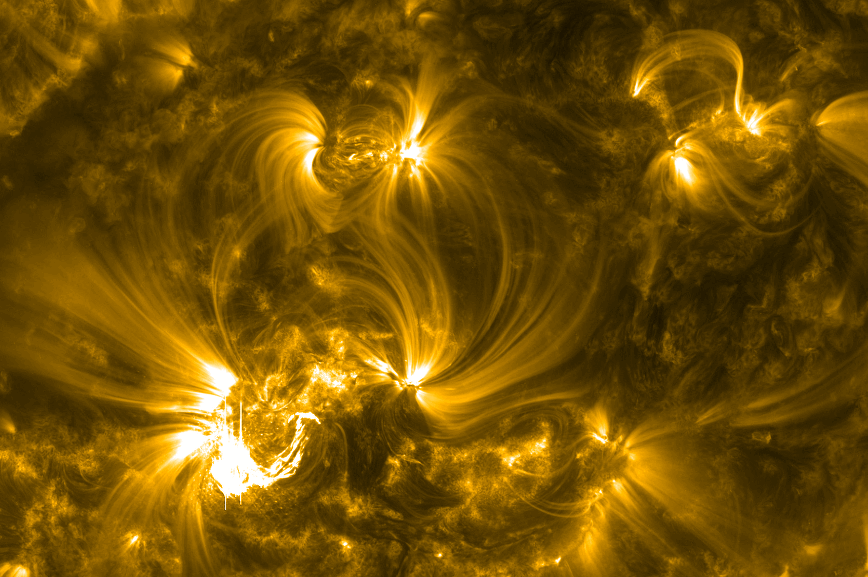
Last week, scientists got a few additional simultaneous flares requiring further investigation. No less than 8 flare events had coinciding brightenings in two or even three well separated sunspot regions. Half of these occurred between NOAA 2035 and 2038. This movie at http://youtu.be/tCOMBEGSo7c shows two examples on 22 and 23 April. It concerns a C2 and C4 flare peaking resp. at 18:41UT and 01:04UT (images underneath). In both cases, the brightening peaked almost at the same moment in the sunspot groups. Note also the small flare south of NOAA 2042 around 23:50UT, which may or may not have initiated the 01:04UT events hardly an hour later. Further research is required to determine if there was a true physical connection or not.
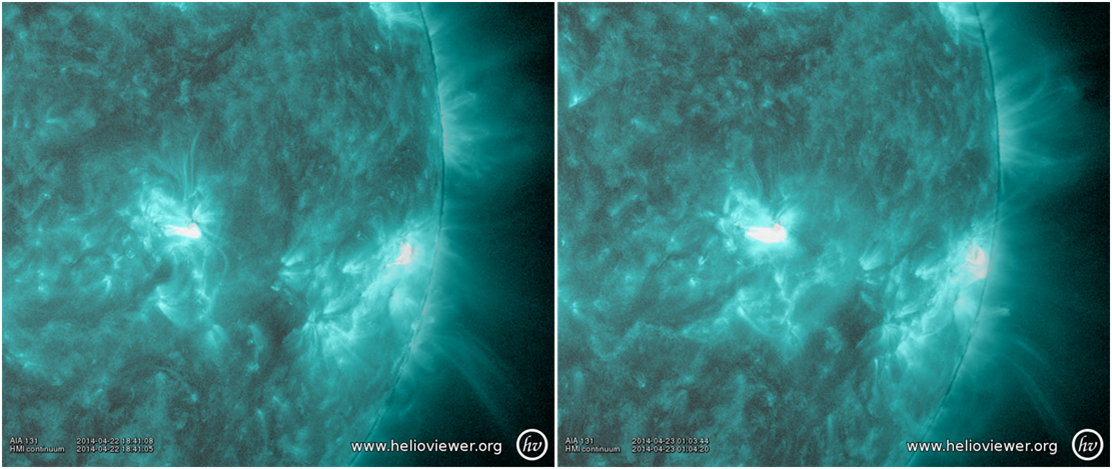
Further reading and movies on this event in this STCE News item (http://www.stce.be/news/x129x/welcome.html ) and in NASA's Science News (http://science.nasa.gov/science-news/science-at-nasa/2010/13dec_globaleruption/ ).
If your dream is to work with satellites, than the team that coordinates the science based on data taken by the scientific instruments SWAP and LYRA onboard of the micro-satellite PROBA2 might be looking for you: to discover the science still hidden in the EUV pictures of the sun and its surrounding corona made with the instrument SWAP or in the intensity curves of the EUV sunlight that LYRA draws.
The PROBA2 guest investigator program offers a few weeks in the PROBA2 science nerve center where you can participate in the daily commanding of SWAP and LYRA, discuss with other experts and gain valuable know-how on solar instrumentation. Maybe this might lead to a science break through.
http://proba2.sidc.be/FifthGICall
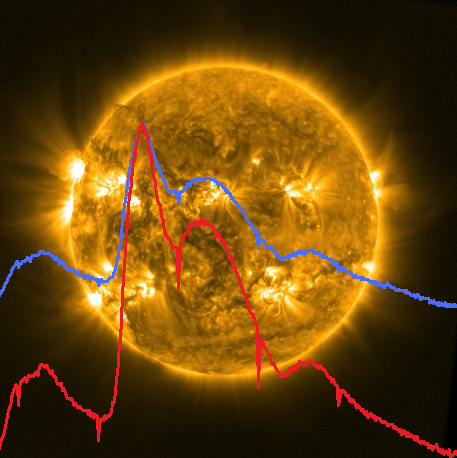
The strongest event of the week was an X1.3 flare that took place on 25 April (maximum at 00:27UT) in NOAA 2035 (see SDO/AIA pictures), which was at the time already 1 day behind the west limb. The associated CME was directed away from Earth.
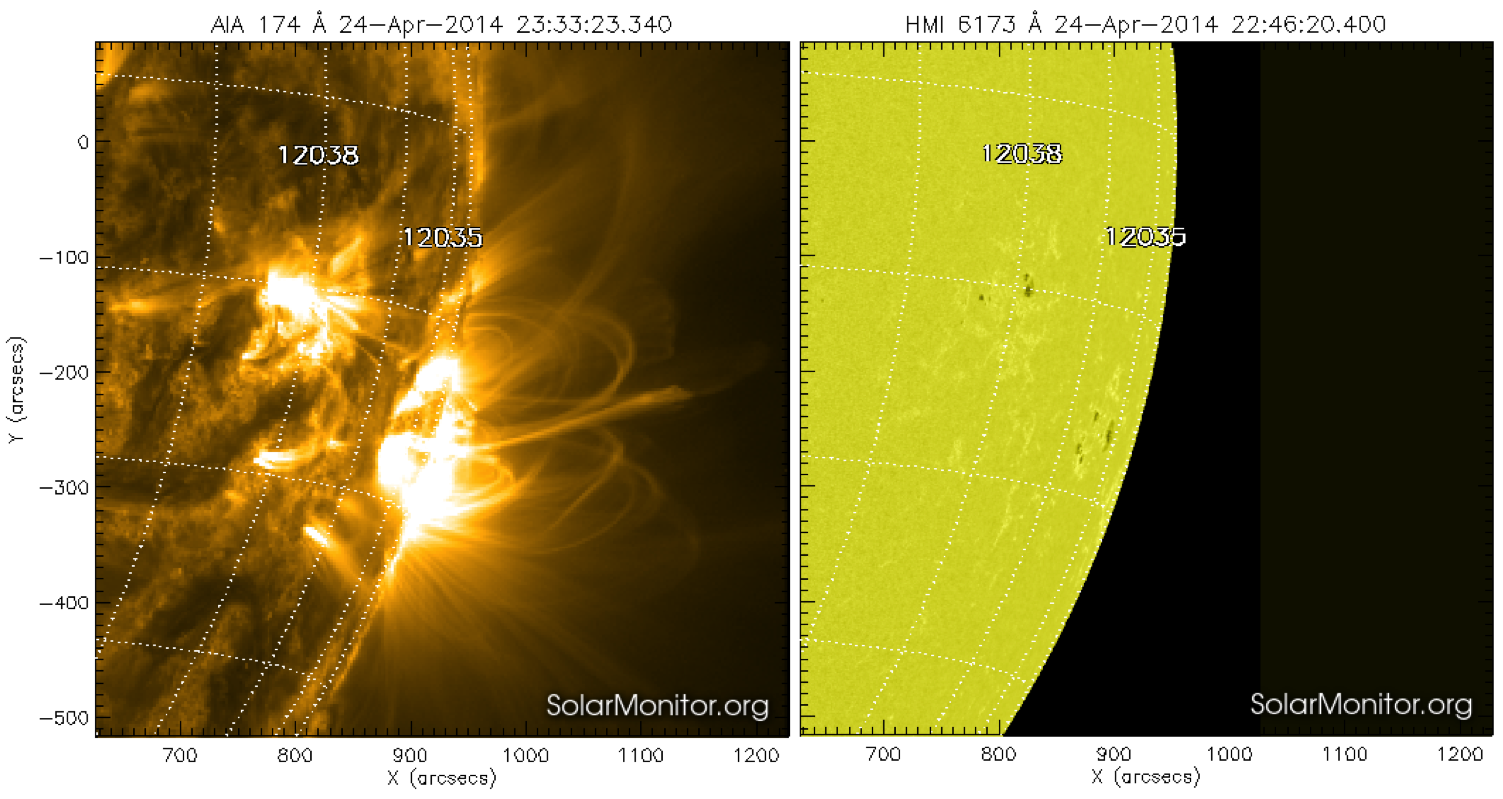
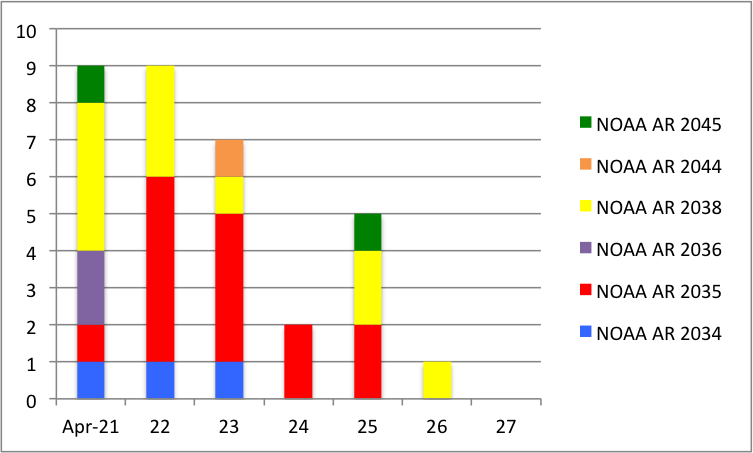
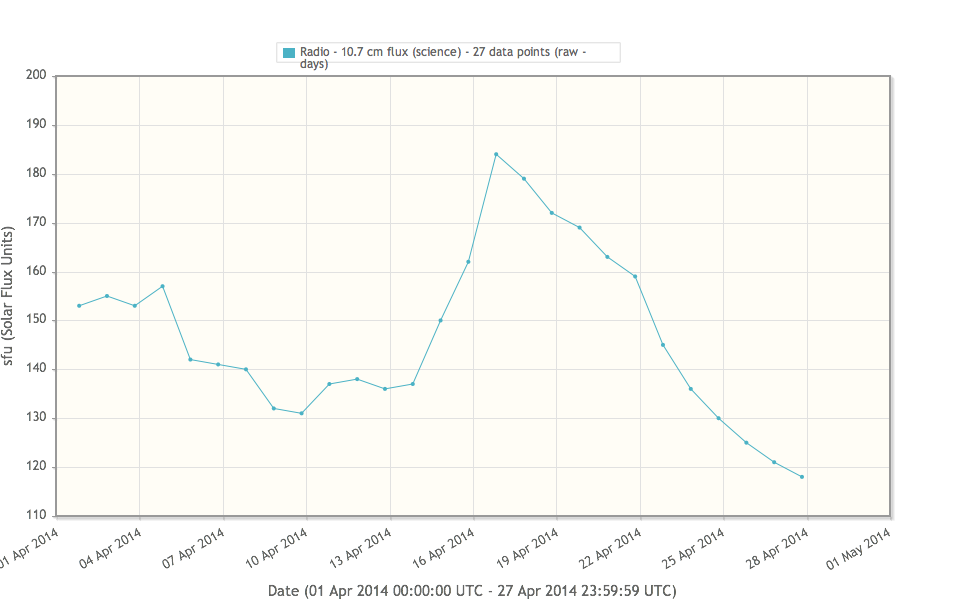
In the wake of the CME-impact (20 April) related to the M7-flare (18 April), the geomagnetic field was initially rather active (21 April). For the remainder of the week, quiet geomagnetic conditions with locally an occasional active period were recorded.
| DAY | BEGIN | MAX | END | LOC | XRAY | OP | 10CM | TYPE | Cat | NOAA |
| 25 | 0017 | 0027 | 0038 | S15W90 | X1.3 | SF | 1100 | V/1II/2 | 2035 |
| LOC: approximate heliographic location | TYPE: radio burst type |
| XRAY: X-ray flare class | Cat: Catania sunspot group number |
| OP: optical flare class | NOAA: NOAA active region number |
| 10CM: peak 10 cm radio flux |
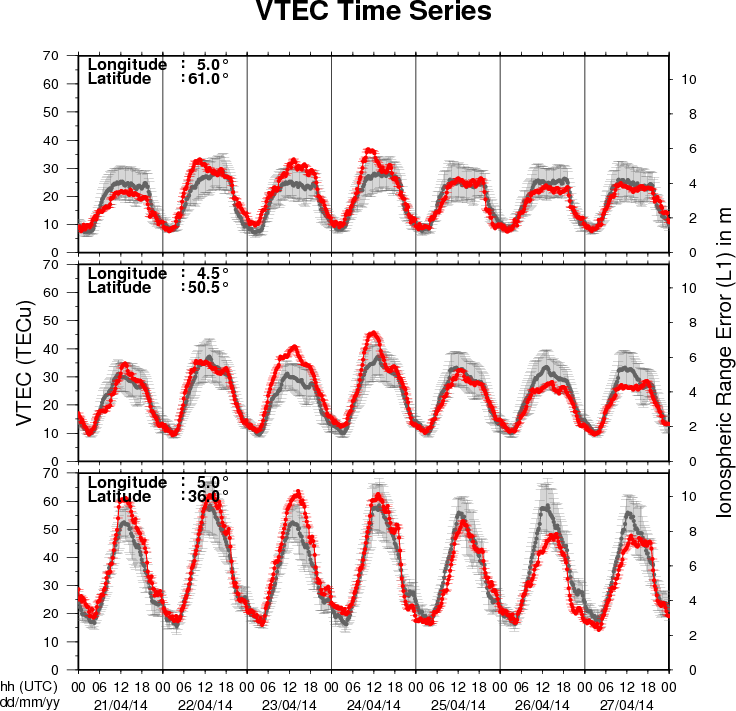
The figure shows the time evolution of the Vertical Total Electron Content (VTEC) (in red) during the last week at three locations:
a) in the northern part of Europe(N61°, 5°E)
b) above Brussels(N50.5°, 4.5°E)
c) in the southern part of Europe(N36°, 5°E)
This figure also shows (in grey) the normal ionospheric behaviour expected based on the median VTEC from the 15 previous days.
The VTEC is expressed in TECu (with TECu=10^16 electrons per square meter) and is directly related to the signal propagation delay due to the ionosphere (in figure: delay on GPS L1 frequency).
The Sun's radiation ionizes the Earth's upper atmosphere, the ionosphere, located from about 60km to 1000km above the Earth's surface.The ionization process in the ionosphere produces ions and free electrons. These electrons perturb the propagation of the GNSS (Global Navigation Satellite System) signals by inducing a so-called ionospheric delay.
See http://stce.be/newsletter/GNSS_final.pdf for some more explanations ; for detailed information, see http://gnss.be/ionosphere_tutorial.php
Start : 2014-06-10 - End : 2014-06-11
The STCE workshop 'Inter-Calibration and Degradation of EUV
Instruments' aims at understanding the differences observed between
the various instruments observing in the SXR-EUV range and at
analyzing the ageing effects that affect their results. It targets
imagers as well as spectrometers and photometers.
The workshop will be followed by two days of working sessions
(June 12-13) organized by the Solar EUV Irradiance Working Group
(also supported by the STCE). These working sessions are in the
continuity of similar events organized in 2011, 2012 and 2013, but
they are open to new participants and you are welcome to join if
you are interested.
Website:
http://www.stce.be/euvworkshop2014/
Start : 2014-06-19 - End : 2014-06-20
During the summer of 2014 DTU Space will host the 3rd Swarm
Science Meeting, sponsored by the European Space Agency, ESA
. This meeting will take place at
the IDA Conference Centre in Copenhagen on June 19th to 20th 2014
and is open to the science community at large.
Website:
http://congrexprojects.com/2014-events/Swarm/home
The STCE Annual Report 2012 is a compilation of the activities done in 2012 within the frame of the Solar-Terrestrial Centre of Excellence (STCE). This report continues the style from the previous edition. Hence, as it is targeting a more general public, it presents only a selection of the 2012-activities in easy-to-digest summaries. These summaries emphasize the intense collaboration between the institutes at the Space Pole, as well as with our external partners. We hope you enjoy this report, which features articles on the evolution of the solar activity, the 9th European Space Weather Week, PROBA2, Integrated Water Vapor observations, SIMBA the nanosatellite, user applications such as STAFF, LIDAR, and ionospheric models, and much more... Happy reading!
http://www.spaceweather.eu/en/repository/show?id=494
http://www.spaceweather.eu/en/repository/show?id=492
http://www.spaceweather.eu/en/repository/show?id=497
http://www.spaceweather.eu/en/repository/show?id=498
Presentation given at the STCE Workshop Science and science operations of the PROBA satellite fleet on the perspective of Belspo on the PROBA series and the Belgian involvement in the European space programmes.
http://www.spaceweather.eu/en/repository/show?id=501
Presentation given at the STCE Workshop Science and science operations of the PROBA satellite fleet on the perspective of QinetiQ Space on the PROBA series.
http://www.spaceweather.eu/en/repository/show?id=502
Presentation given at the STCE Workshop Science and science operations of the PROBA satellite fleet on Proba-1 and Proba-V as part of the ESA's Earth Observation Programme.
http://www.spaceweather.eu/en/repository/show?id=503
Presentation given at the STCE Workshop Science and science operations of the PROBA satellite fleet about the PROBA2 science operations.
http://www.spaceweather.eu/en/repository/show?id=504
Presentation given at the STCE Workshop Science and science operations of the PROBA satellite fleet on the new operational mission PROBA-V, an earth observing satellite.
http://www.spaceweather.eu/en/repository/show?id=505
Presentation given at the STCE Workshop Science and science operations of the PROBA satellite fleet about the operations at the PROBA satellites "nursery".
http://www.spaceweather.eu/en/repository/show?id=506
Presentation given at the STCE Workshop Science and science operations of the PROBA satellite fleet on a PROBA-V experimental moon calibration method.
http://www.spaceweather.eu/en/repository/show?id=507
Presentation given at the STCE Workshop Science and science operations of the PROBA satellite fleet on the instrument aspects, operations and science of the Energetic Particle Telescope (EPT) onboard of PROBA-V.
http://www.spaceweather.eu/en/repository/show?id=508
Presentation given at the STCE Workshop Science and science operations of the PROBA satellite fleet on the challenges and successes of the coronal images SWAP onboard of PROBA2.
http://www.spaceweather.eu/en/repository/show?id=509
Presentation given at the STCE Workshop Science and science operations of the PROBA satellite fleet on the Large-Yield Radiometer (LYRA) onboard of PROBA2. LYRA measures the solar irradiance in 4 bandpasses with 3 types of detectors.
http://www.spaceweather.eu/en/repository/show?id=510
Presentation given at the STCE Workshop Science and science operations of the PROBA satellite fleet on the results and operations of the micro-cameras onboard of PROBA-1 and PROBA2.
http://www.spaceweather.eu/en/repository/show?id=511
Presentation given at the STCE Workshop Science and science operations of the PROBA satellite fleet on the impacts of the Low Earth Orbit radiation environment on PROBA satellites.
http://www.spaceweather.eu/en/repository/show?id=512
Presentation given at the STCE Workshop Science and science operations of the PROBA satellite fleet on ALTIUS, an Atmospheric Limb Tracker for Investigation of the Upcoming Stratosphere.
http://www.spaceweather.eu/en/repository/show?id=513
Presentation given at the STCE Workshop Science and science operations of the PROBA satellite fleet on the future PROBA-3 satellite. PROBA-3 consists of 2 spacecraft flying in formation. The inner-satellite acts as the occulter for a chronograph observing the solar atmosphere.
http://www.spaceweather.eu/en/repository/show?id=514
Presentation given at the STCE Workshop Science and science operations of the PROBA satellite fleet on the study of a Passive Companion Micro-Satellite to the SAOCOM-1B Satellite of Argentina, for bistatic and interferometric SAR applications.
http://www.spaceweather.eu/en/repository/show?id=515
Presentation given at the STCE Workshop Tomography and 3D reconstruction in space science, April 2014 on 3D CME reconstruction: constraints, methods and an application.
http://www.spaceweather.eu/en/repository/show?id=516
Presentation given at the workshop Tomography and 3D reconstruction in space science, April 2014 on temperature and density reconstruction of coronal structures. The technique which is based on Python is applied to polar plumes observed in SDO/AIA images.
http://www.spaceweather.eu/en/repository/show?id=517
Presentation given at the workshop Tomography and 3D reconstruction in space science, April 2014 about the work performed at Vision Lab ASTRA: All Scale Tomographic Reconstruction Antwerp.
http://www.spaceweather.eu/en/repository/show?id=518
Presentation given at the workshop Tomography and 3D reconstruction in space science, April 2014 on how the 2D energy spectra of electron above the auroral arcs are estimated. The technique uses optical ground-based observations done with ALIS, Auroral Large imaging System.
http://www.spaceweather.eu/en/repository/show?id=519
Raising awareness and get people outside the scientific community involved in space weather becomes more and more an issue. To cross the borders of our science project eHEROES, we came up with a tide communication plan that answers the questions: what, to whom, why, when, how, by whom? The key is to link the audience and your message in a correct way. Both formal and informal education are on our tool list.
This is an invited poster presented at EGU, 2014 in the session
Raising and maintaining awareness of our local space weather: education and public outreach.
eHEROES, Environment for Human Exploration and RObotic Experimentation in Space is an FP7 project (n° 284461, www.eheroes.eu).
http://www.spaceweather.eu/en/repository/show?id=520